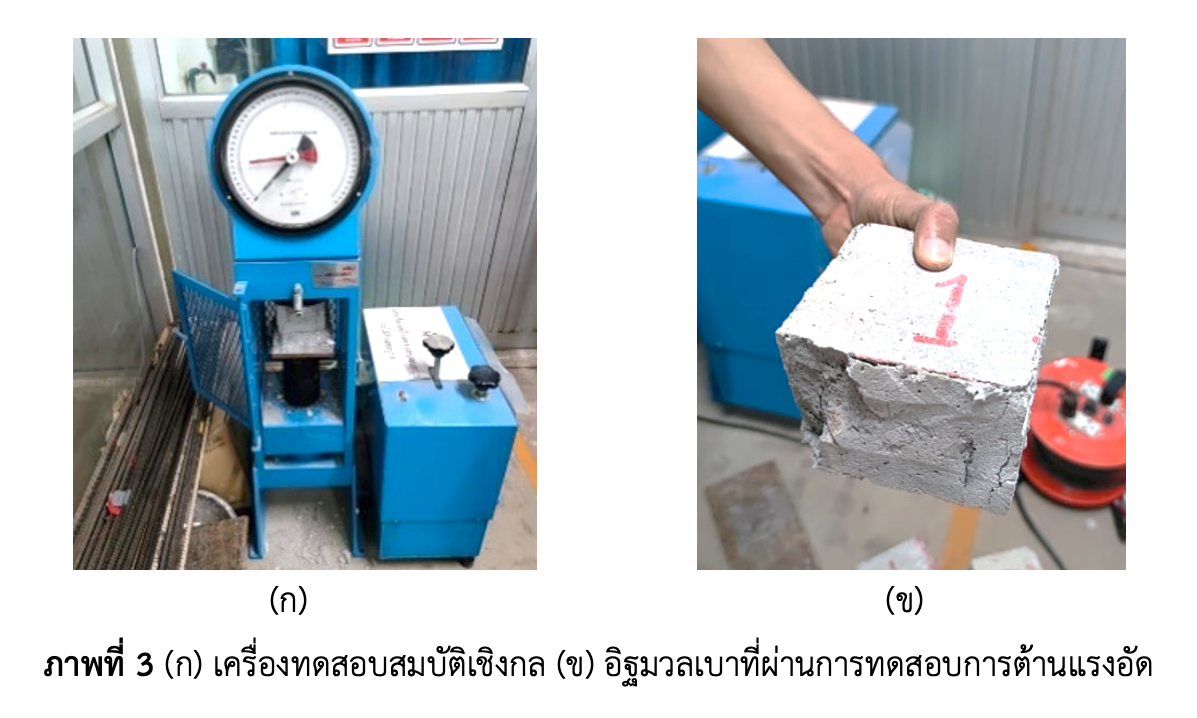Effect of rice husk ash used as pozzolan material on properties of lightweight bricks
Main Article Content
Abstract
This research aimed to investigate the effect of rice husk ash as a reinforcing material (Pozzolan) in the production of lightweight bricks with dimensions of width 20 cm, length 60 cm, and thickness 7.5 cm (lightweight brick size according to the standards of the Department of Industrial Promotion). Production of non-autoclaved system type 1 uses light materials in the production process include portland cement, fine sand, aluminum powder, lime, gypsum, and reinforcing materials (finely rice husk sintered at 600oC for replacing sand in the amount of 3 formulas, such as 5 wt%, 10 wt% and 15 wt%). The brick was cured with water for seven days. Testing properties of lightweight bricks include compressive strength, water absorption rate, and density. The data were analyzed using descriptive statistics such as mean and standard deviation. The results showed that all lightweight bricks had compressive strengths between 7.38 ± 0.42 to 12.68 ± 1.27 MPa. The means compressive strength of the sample with 10 wt% of rice husk ash (12.68±1.27 MPa) was approximately the same as the control unit (13.28 ± 0.42 MPa), water absorption rate 15.4 ± 1.48%, density 1.47 ± 0.01 kg/m3, and the production cost of materials is approximately 16.47 baht (137.2 baht/m2). Therefore, rice husk ash can be used as a raw material for producing lightweight bricks, and the bricks with a 10 wt% of rice husk ash can be used to produce bricks for masonry walls or indoor partitions that are not part that supports the weight of the building structure.
Article Details

This work is licensed under a Creative Commons Attribution-NonCommercial-NoDerivatives 4.0 International License.
The Journal of Science and Science Education (JSSE) retain the right of all articles published in JSSE. The coresponding author or the authorized person on behalf of the authors must send the complete Copyright Transfer Form to JSSE before any article get published in JSSE.
Copyright Transfer Form
The JSSE request the coresponding author or the authorized person on behalf of the authors upload the manuscript under the together with the Copyright Transfer Form under the supplementary data. The guidline for uploading both manuscript and Copyright Transfer Form is shown below:
1. Upload the manuscript in the sub-menu, Article Component > Article Text.
2. Upload the the Copyright Transfer Form in the sub-menu, Article Component > Other.
Download Copyright Transfer Form
References
Chaichana, V. (2019). Production of light brick using rice husk ash as an ingredient (in Thai). Research Report. Bangkok: Rajabhat Maha Sarakham University.
Chindaprasirt, P. and Jaturapitakkul, C. (2013). Cement Pozzolan and Concrete, 7thedition (in Thai). Bangkok: thailand concrete association.
Chindaprasirt, P., Songpiriyakij, S., Rattanasak, U. and Pruksanukul, S. (2020). Dimensional stability of Lightweight Concrete (in Thai). Research Report. Bangkok: Thailand Science Research and Innovation.
Dolah, N. (2009). Light materials used in construction Industry (in Thai). Princess of Naradhiwas University Journal, 1(3), 48-62.
Faculty of Engineering Civil Engineering University of Phayao. (2016). Determination of size, density, moisture and water absorption of bricks (in Thai). Retrieved 8 February 2022, from Faculty of Engineering Civil Engineering University of Phayao http://engineeringmaterialsproject.blogspot.com/2015/12/1.html
Ministry of Industry. (1998). Thai industrial standard (Tis no. 1505-2541) Autoclaved aerated lightweight concrete elements (in Thai). Retrieved 30 November 2021, from Ministry of Industry: http://www.fio.co.th/web/tisi_fio/fulltext/TIS1505-2541.pdf
Muangtong, P., Kongpun, T. and Nekhamanurak, B. (2014). Influence of Pozzolan Materials, Agricultural Waste, on Mechanical Properties of Soil-Cement Brick (in Thai). Research report. Bangkok: Rajamangala University of Technology Rattanakosin.
Office of the Basic Education Commission. (2021). Accounting of construction materials and labor costs for the year 2022 (in Thai). Retrieved 28 March 2022, from Office of the Basic Education Commission. https://rnedu.go.th/2019/wp-content/uploads/2021/11
Onprom, P. (2021). Influence of Glass Cullet as Partial Replacement of Fine Aggregate on Concrete Block Properties (in Thai). Vocational Education Innovation and Research Journal, 5(1), 32-39.
Panel hoszigeteles Co., Ltd. (2017). Properties of heat-insulating bricks or lightweight bricks (in Thai). Retrieved 8 February 2022, from Panel Hoszigeteles: https://www.panelhoszigeteles.com/category/%E0%B8%9C%E0%B8%A5%E0%B8%B4%E0%B8%95%E0%B8%A0%E0%B8%B1%E0%B8%93%E0%B8%91%E0%B9%8C/page/3
Sata, V., Tangpagasirt, J., Jaturapitakkul, C. and Chindaprasirt, P. (2012). Effect of W/B ratios on pozzolanic reaction of biomass ashes in Portland. Cement & Concrete Composites, 34(1), 94-100.
Sinsiri, T. (2014). High strength cellular aerated concrete (in Thai). Research report. Bangkok: Science and Technology Infrastructure Databank (STDB).
Sirisurawong, E. (2015). Development of the cement replacement material from water treatment sludge and rice husk ash (in Thai). Master’s Thesis. Nakhon Ratchasima: Suranaree University of Technology.
Senaart, N. and Nonthawee, P. (2019). Production of worm bricks from water supply sludge, Ubon Ratchathani University (in Thai). Research report. Ubon Ratchathani: Ubon Ratchathani University.
The securities and exchange commission. (2013). Smart concrete public company limited (in Thai). Retrieved 28 April 2022, from The Securities and Exchange Commission: http://capital.sec.or.th/webapp/corp_fin/datafile/69/2013/132800110401012013-04-


